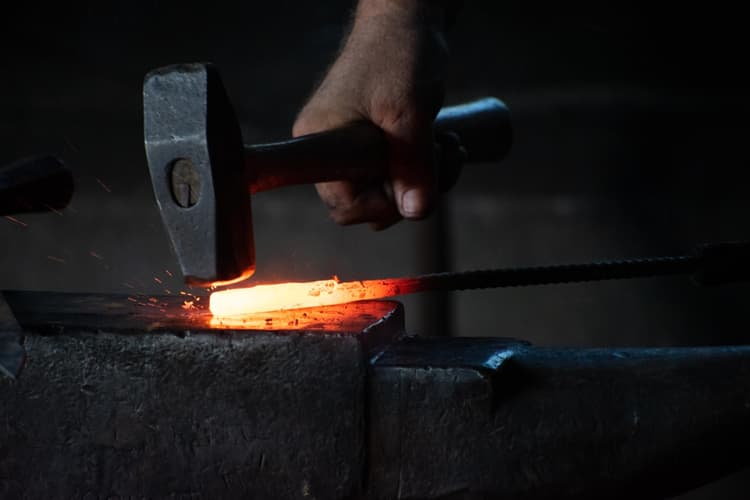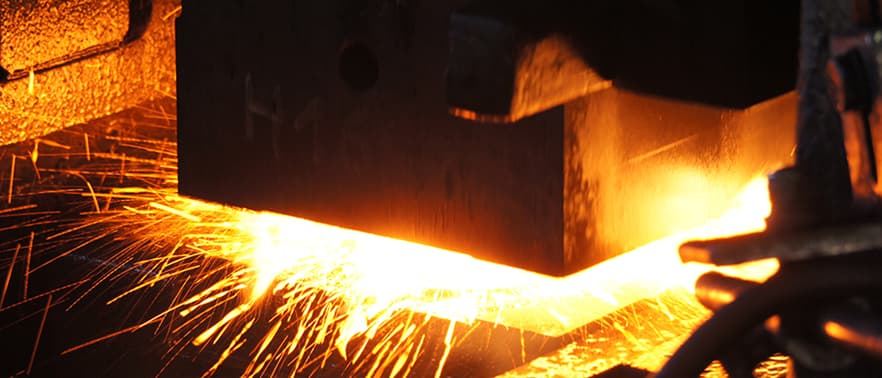Forging Of Steel
Depending on the forming temperature steel forging can be divided into three process type. These are; hot forging of steel, warm forging of steel, and cold forging of steel. Firstly we desscribe hot forging of steel properties; forging temperatures above the recrystallization temperature between 950–1250 °C, good formability, low forming forces aand constant tensile strength of the workpieces, warm forging properties of steel, forging temperatures between 700–1000 ° C, less or less scalable on the workpiece surface, smaller resistance than hot forging, higher forming forces than appear for certain forming and hot forging, and lower forming compared to cold forming are in the form of forces. Third and its features; Forging temperatures in room conditions, self-heating resistance capacity up to 150 ° C due to forming energy, no scaling on the workpiece, increase in strength and decrease in flexibility due to strain hardening and low formability and high forming forces are required. For industrial processes, steel alloys are first forged in a hot position, while brass, copper, bronze, precious metals and these alloys are produced by cold forging processes, each metal requires a separate forging temperature.

Why It Is Used?
The forging process can create parts that are stronger than those manufactured by any other metalworking process and this is why forgings are almost always used where reliability and human safety are critical [10].
- Compared to Castings
Forging are stronger than casts compared to them. Casting cannot positively affect the properties of the material by hot and cold work, and forging removes the defects of casting ingots and continuous casting. Since there is no grain flow and directional force in casting, some defects cannot be prevented and dendritic structures, alloy separation etc. removed in the forging process. Hot working does not require much control like casting as it improves its high strength, ductility and resistance properties and is economically beneficial.
Castings require close control of the melting and cooling processes as alloy decomposition can occur, resulting in a non-uniform heat treatment response that can affect the flatness of the finished parts; moreover, forgings give a more predictable response to heat treatment and offer better dimensional stability, and forgings are flexible, cost-effective production tailored to demand.
Compared to Weldments/Fabrications
Production economy by forging saves material; Also, welded fabrications are more costly in high volume production. In fact, fabricated parts are a traditional forging conversion resource as production volume increases, and first tooling costs for forging can be borne by production volume and material savings, and the unique manufacturing economy of the forging, lower labor costs, scrap and rework reductions, and reduced inspection costs. Welded structures are generally non-porous and any strength benefits derived from welding or fixing standard rolled products may be lost with the application of poor welding or joining; Also, the grain orientation obtained in the forging process creates stronger parts. A multi-component welded assembly is far inferior to the economic gain from a forging process; In addition, welded assemblies for high stress components require costly inspection procedures.
Selective heating and non-uniform cooling occurring in the weld can give undesirable metallurgical properties such as inconsistent grain structure, in use, a welded seam may act as a metallurgical notch that can lead to part failure; Also, Forging do not have internal voids that cause unexpected failure under stress or impact.
Compared to Powder Metal Parts (P/M)
Forgings are stronger, low standard mechanical properties are characteristic of P / M parts, but the grain flow of a forging provides strength at critical stress points. Costly part density change or leakage is required to avoid P / M defects, but grain refinement of forged parts ensures metal strength and absence of defects. Less secondary machining is required by forging, but P / M shapes, threads and holes and fine tolerances may require extensive machining, secondary forging can often be reduced to finishing, drilling and other simple steps. P / M shapes are limited to those that can be removed in the printing direction, but forging allows for part designs that are not limited to shapes in that direction. Less costly materials are used by forging.
For further information please read: Types Of Forging
References
[1] Cast steel: Forging, archived from the original on 18 February 2009, retrieved 3 March 2010
[2] Retriewed from: https://www.forginal-industrie.com/en/expertise/technical-forging/
[3] Kaushish, J. P. (2008), Manufacturing Processes, PHI Learning, p. 469,
[4] Retriewed from: https://www.manufacturingguide.com/en/open-die-forging
[5]Retriewedfrom:https://www.schulergroup.com/major/us/technologien/produkte/grundlagen_massivumformung_gesenkschmieden/index.html
[6] 50,000 Ton Closed Die Forging Press (PDF). American Society of Mechanical Engineers. 1981. Archived from the original (PDF) on 2012-02-27. Retrieved 2012-05-15.History of the Mesta Press at Alcoa
[7] Retriewed from: https://thepipefitting.com/what-is-press-forging-process.html
[8] Degarmo, E. Paul; Black, J. T.; Kohser, Ronald A. (2011). Materials and Processes in Manufacturing (11th ed.). Wiley
[9] Retriewed from: https://www.qcforge.com/forging-knowledge/
[10] Doege, E., Behrens, B.-A.: Handbuch Umformtechnik: Grundlagen, Technologien, Maschinen (in German), Springer Verlag, 2010, p. 7


